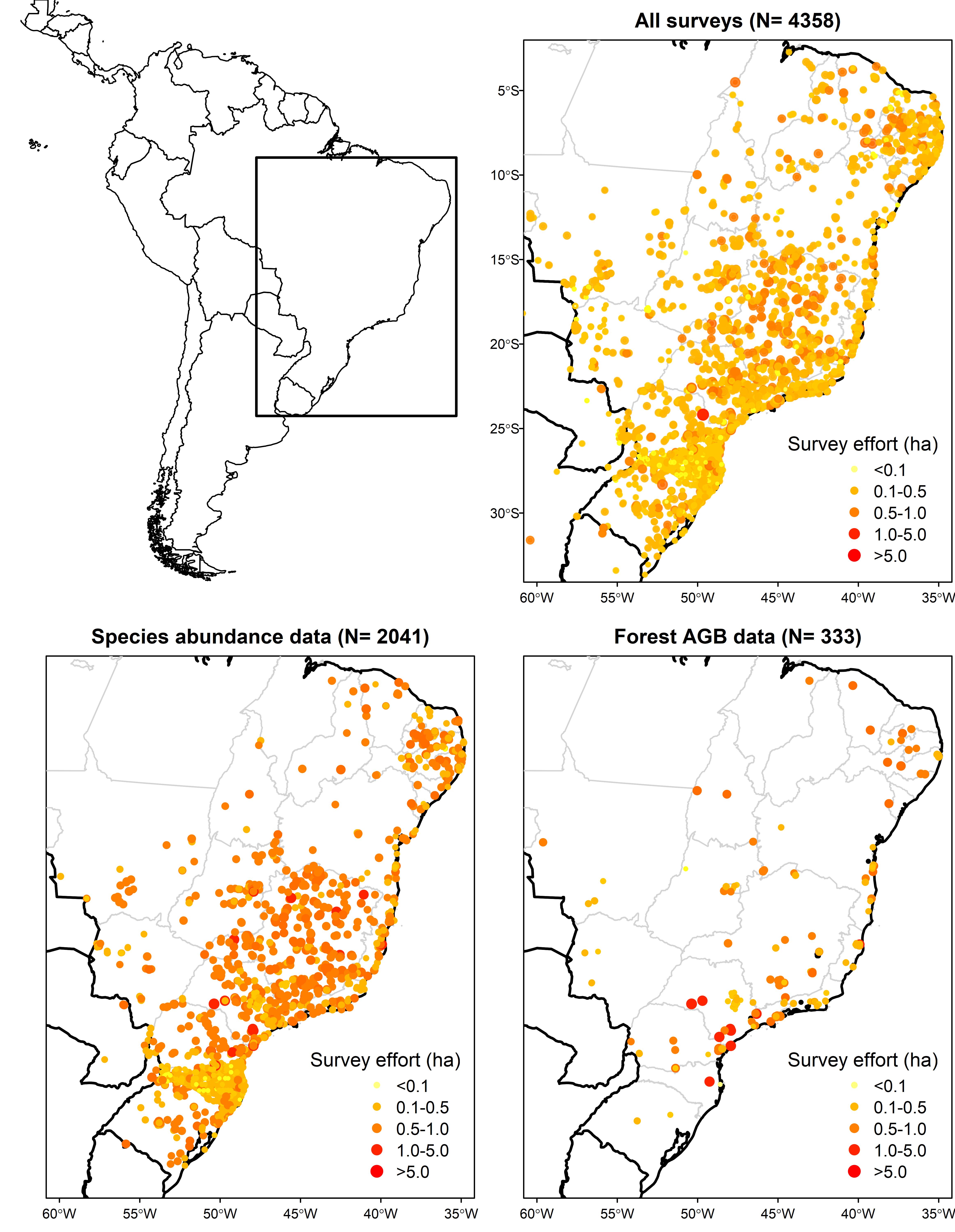Neotropical Tree Communities database (TreeCo)
 A project that aims to compile and synthesize the existing knowledge on the structure and diversity of neotropical tree communities and the functional traits of their species. Currently, the project mainly contains information from the forests and shrublands of eastern South America, including the Atlantic Forest, Cerrado, Caatinga and Pantanal domains (i.e. extra-Amazonian neotropical domains). It includes surveys of all vegetation types, successional stages and sampling methods. The database is currently in version 4.0.
Read More
A project that aims to compile and synthesize the existing knowledge on the structure and diversity of neotropical tree communities and the functional traits of their species. Currently, the project mainly contains information from the forests and shrublands of eastern South America, including the Atlantic Forest, Cerrado, Caatinga and Pantanal domains (i.e. extra-Amazonian neotropical domains). It includes surveys of all vegetation types, successional stages and sampling methods. The database is currently in version 4.0.
Read More
IMPORTANT NOTE: This project is no longer funded and it is maintained in the free time of its coordinators. The database is currently being used by many projects and has received an increasing number of new requests, a number well above what the coordinators can manage. Therefore, replies to data requests may be delayed (weeks or more). Priority is given to requests that can improve the quality of the database instead of just using it.
People
- Associate researchers: Luiz F.S. Magnago (UFSB), Sandra C. Müller (UFRGS), Daniel Piotto (UFSB), Rodrigo S. Bergamin (UFRGS), Victor P. Zwiener (UFPR) & André L. de Gasper (FURB)
- Grad students: Guilherme Gritz & Jean M. Freitag Kramer
- Labs involved: LET/IB/USP, LABTROP/IB/USP, LEVEG/UFRGS, LEAFS/UFSB & Plant Ecology and Biogeography/UFPR
The database
So far, TreeCo is composed by two main bodies of information:
- A cloud service used to store digital copies of the studies and documents related to TreeCo.
- A series of tables storing information on:
- bibliographic references of quantitative tree community surveys
- study methods: sampling design, methods, effort, …
- forest description: coordinates, fragment size, forest type, forest disturbance level, …
- site environment: altitude, soil conditions, rainfall, temperature, …
- landscape metrics: forest cover, mean area and distance between patches, …
- species abundances data: counts of individuals and total basal area per species per site
- species traits: wood density, maximum height, leaf area, seed/fruit size, among others, obtained mainly from the literature but also from (un)published field measurements
Database overview - July 2020
Studies and inventories data
- Number of quantitative plant community studies retrieved: 1790
- Number of inventories retrieved: 4466
- Atlantic Forest: 3143
- Cerrado: 852
- Caatinga: 309
- Pantanal: 113
- Amazon: 25
- Pampa: 24
Species abundance data
- Number of inventories entered: 1982
- Number of abundance records: 139,761
- Overall sampling effort: 1735 hectares and 1,992,721 trees
- Number of families, genera and valid species: 139, 771 and 4006
Species functional trait data (all sources)
- Number of traits with information: 74
- Overall number of trait records: 110,220
- Traits with higher species coverage within Treeco abundance data (~3500 spp):
- Wood density: 91% (46% and 45% at species and genus level)
- Maximum height: 92%
- Leaf area: 56%
- Leaf type: 63%
- Leaf hairness: 51%
- Leaf rigidness: 48%
- Seed size: 64%
- Dispersal syndrome: 69%
- Ecological groups: 53%
 Figure 1. The current geographical extent covered by TreeCo (top left), the distribution of all the quantitative vegetation inventories stored in the database (top right), the inventories with species abundance data already entered in the database (bottom left), and the inventories with information on Tree Above-ground Biomass (AGB), excluding data from state forest inventories (bottom right). Thick lines present the official limits of Latin America, while the grey lines define the Brazilian states. The number of inventories with geographical coordinates (N) is given for each panel.
Figure 1. The current geographical extent covered by TreeCo (top left), the distribution of all the quantitative vegetation inventories stored in the database (top right), the inventories with species abundance data already entered in the database (bottom left), and the inventories with information on Tree Above-ground Biomass (AGB), excluding data from state forest inventories (bottom right). Thick lines present the official limits of Latin America, while the grey lines define the Brazilian states. The number of inventories with geographical coordinates (N) is given for each panel.
Sample of TreeCo data (list of fields available)
The file below provides an example of how some TreeCo site, abundance and trait data are stored and the details on each of the information. This may be used to evaluate if TreeCo has the information you are looking for and how it is organized if you want to contribute data: TreeCo_tables_and_descriptions
Data sharing and collaboration
TreeCo is available upon reasonable request from researchers interested in using the database for scientific purposes. We may share all the data available as long as there is no overlap with ongoing projects, and if references and funding sources are properly cited. We are also more prone to share TreeCo data with researchers willing to give their input on the quantity/quality of the database than only using it. Young and early-career researchers willing to use the database in their grad or post-doc projects are especially welcome, particularly those from institutions in the Global South.
TreeCo coordinators are also open for collaboration on the research topics listed below ('Future research topics'). We are glad to provide lists of references and to share pdf copies of any study we may have. The use of other information stored in the database, such as the species composition, abundance, trait and site information, is also possible. But in this case, it may imply the participation of the project coordinators in the investigation and related publications. These decisions are made on a case-by-case basis and they depend on the scale of the study propose and the actual participation of coordinators in the project.
To speed up the sharing process of TreeCo data, please read carefully the information above and provide with your request the title and goals of the project, the name of people, institutions, grad schools, and funders involved. For requesting access to TreeCo species trait data, please also provide a list of the plant taxa and traits.
Ongoing projects
- Lima, RAF et. al. Fragmentation effects on the commonness and rarity of Atlantic Forest trees. Naturalis Biodiversity Center.
- Lima, RAF & Prado, PI O papel da diversidade funcional na estruturação de comunidades arbóreas tropicais.
- Pitta, G, Prado, PI & Lima, RAF. The carbon balance in the Atlantic forest. A case study for SP-Brazil. MSc. project. Universidade de São Paulo (USP).
- Mori, DP, Lima, RAF & Prado, PI. O papel da fragmentação nos processos que estruturam comunidades arbóreas. MSc. project. Universidade de São Paulo (USP).
Future research topics
The main scientific questions we want to answer using TreeCo are related to the following topics:
- Environment effects on the parameters of the species abundance distribution (SAD)
- Relationships between SAD built using counts of individuals and biomass
- Environment and distance effects on beta-diversity
- Environmental filtering on species traits (trait variation)
- Trade-offs in functional traits of Atlantic Forest species
- Phylogenetic structure along environmental gradients
- Abundance-range size relationships and concept of rarity
- Trait effect on species niche size/breath or geographical distribution
- Indicator species of the Neotropical Forest subtypes
- Differences and similarities in the structure and diversity of Neotropical Forest subtypes
Publications using TreeCo database
- Lima, R.A.F. et al. 2024. Comprehensive conservation assessments reveal high extinction risks across Atlantic Forest trees. Science 383(6679): 219-225.
- Almeida, C. et al. 2024. Restoration plantings in the Atlantic Forest use a small, biased, and homogeneous set of tree species. Forest Ecology and Management 553: 121628.
- Pyles, M.V. et al. 2022. Human impacts as the main driver of tropical forest carbon. Science Advances 8(24): eabl7968.
- Klipel, J. et al. 2022. Climatic distribution of tree species in the Atlantic Forest. Biotropica 54(5): 1170-1181.
- Pinho, B.X. et al. 2022. Cross‐scale drivers of woody plant species commonness and rarity in the Brazilian drylands. Diversity and Distributions 28(7): 1497-511.
- Marjakangas, E.‐L. et al. 2021. Co-occurrences of tropical trees in eastern South America: disentangling abiotic and biotic forces. Plant Ecology 222: 791–806.
- Zwiener, V.P., Lima, R.A.F. et al. 2021. Tree diversity in the Brazilian Atlantic Forest: biases and general patterns using different sources of information. Chapter 6 in: Atlantic Forest: history, biodiversity, threats and opportunities of the mega-diverse forest. Springer, Cham.
- Lima, R.A.F. et al. 2020. The erosion of biodiversity and biomass in the Atlantic Forest biodiversity hotspot. Nature Communications 11: 6347.
- Marjakangas, E.‐L. et al. 2019. Fragmented tropical forests lose mutualistic plant–animal interactions. Diversity and Distributions 26(2): 154-168.
- Lima, R.A.F. et al. 2018. Can plant DNA barcoding be implemented in species-rich tropical regions? A perspective from São Paulo State, Brazil. Genetics and Molecular Biology, 41(3): 661-670.
- Marjakangas, E.-L. et al. 2018. Estimating interaction credit for trophic rewilding in tropical forests. Philosophical Transactions of the Royal Society B: Biological Sciences 373(1761): 20170435.
- Brancalion, P.H.S. et al. 2018. Maximizing biodiversity conservation and carbon stocking in restored tropical forests. Conservation Letters 11(4): e12454.
- Sobral-Souza, T. et al. 2017. Rewilding defaunated Atlantic Forests with tortoises to restore lost seed dispersal functions. Perspectives in Ecology and Conservation, 15(4): 300-307.
- Bello, C. et al. 2015. Defaunation affects carbon storage in tropical forests. Science Advances, 1(11): e1501105.
- Lima, RAF et al. 2015. How much do we know about the endangered Atlantic Forest? Reviewing nearly 70 years of information on tree community surveys. Biodiversity and Conservation, 24(9): 2135-2148.
Acknowledgments
We are grateful for the hundreds of researchers, students and technicians that performed fieldwork, species identification and data analysis that resulted in the published and unpublished inventories that are included in TreeCo.
We also thank all people that have directly contributed to surveys and species data compilation, namely Gregory Pitta, Danilo Mori, Luiz Magnago, Markus Gastauer, Carolina Bello, Renato Toledo, Natália Targhetta and Geison Castro.
We are also greatly in debt with the researchers that provided their (un)published tree data: André Amorim, Andréia A. Rezende, Bruno R. Ribeiro, João A. Meira-Neto, João L.F. Batista, Marcelo Pansonato, Márcia C.M. Marques, Maria T.Z. Toniato, Maira C. Pardgurschi, Mario J. Marques-Azevedo, Markus Gastauer, Ricardo R. Rodrigues, Robson L. Capretz and Victor P. Zwiener.
Funding
TreeCo database was funded by the São Paulo Research Foundation (FAPESP) grant 2013/08722-5 and by the European Union’s Horizon 2020 research and innovation program under the Marie Sklodowska-Curie grant agreement no. 795114.
The forest inventories compiled by TreeCo were funded by many different agencies, such as the Coordination for the Improvement of Higher Education Personnel (CAPES), by the National Council for Scientific and Technological Development (CNPQ) and by the many state-specific research funding agencies, such as FAPESP, FAPEMIG, FAPESC, FAPERJ, etc. These agencies funded the scholarships, fieldwork and/or equipment used to conduct these inventories.
We acknowledge some specific funding that resulted in the (un)published data included in TreeCo: São Paulo Research Foundation (FAPESP), grants 1999/08515-0, 1999/09635-0, 2003/12595-7 and 2004/04820-3. Santa Catarina Research Foundation (FAPESC), grant 2017TR1922. Conselho Nacional de Desenvolvimento Científico e Tecnológico (CNPq), grant 312075/2013-8 and 484747/2011-8. US Department of Energy grant DE-FC26-01NT411151 (US Department of Energy).
If you think there is any major funding that should be added to this list, please e-mail the funding agency and grant number to raflima@usp.br.